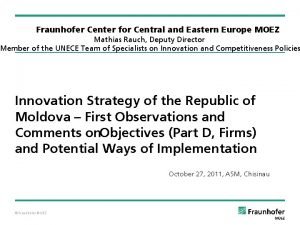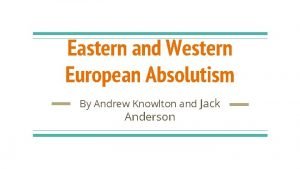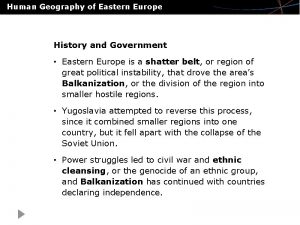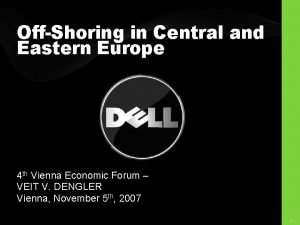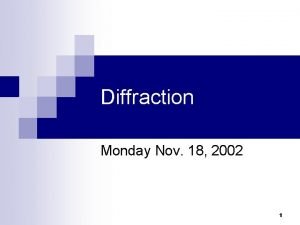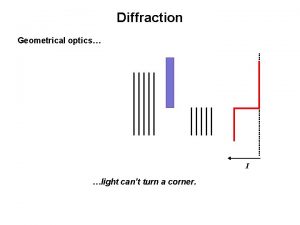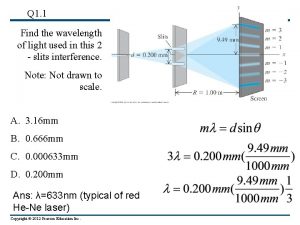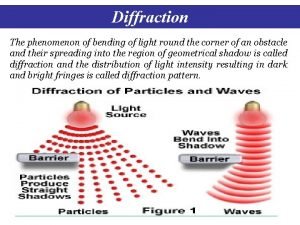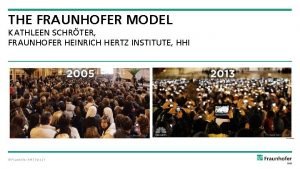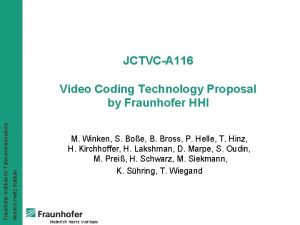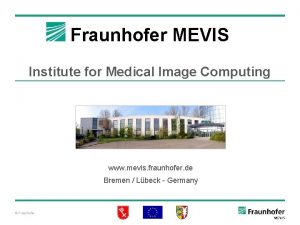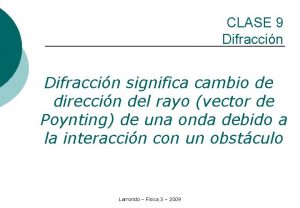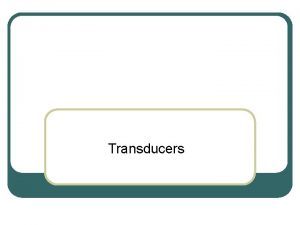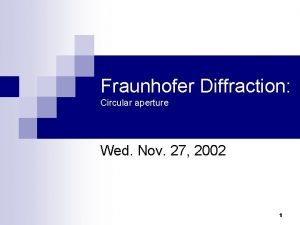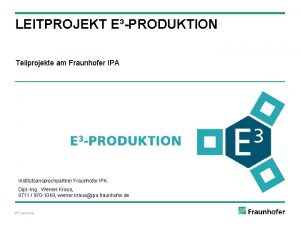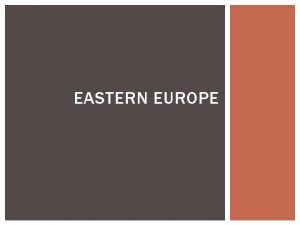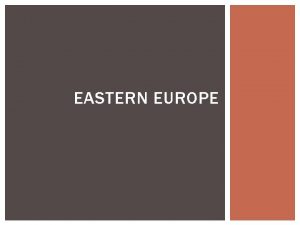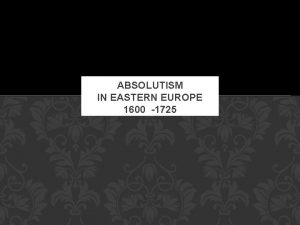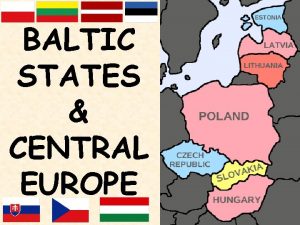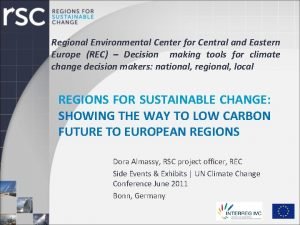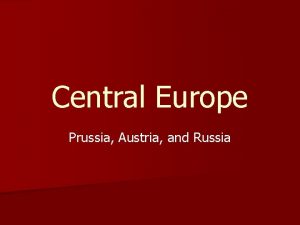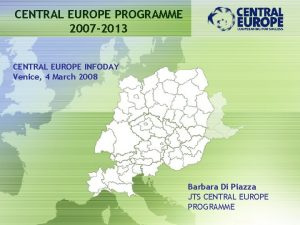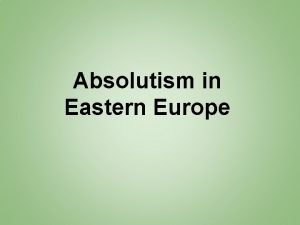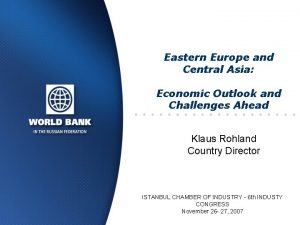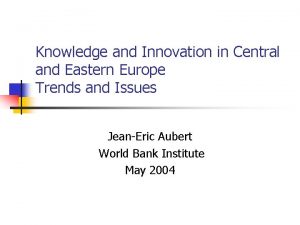Fraunhofer Center for Central and Eastern Europe MOEZ























- Slides: 23

Fraunhofer Center for Central and Eastern Europe MOEZ Mathias Rauch, Deputy Director Member of the UNECE Team of Specialists on Innovation and Competitiveness Policies Innovation Strategy of the Republic of Moldova – First Observations and Comments on. Objectives (Part D, Firms) and Potential Ways of Implementation October 27, 2011, ASM, Chisinau © Fraunhofer MOEZ

Structure of Presentation 1 3 Approaching the strategy: key questions and sequential breakdown Conclusion and key messages 2 Strategy objectives (Part D, Firms): 2. 1 2. 2 2. 3 2. 4 © Fraunhofer MOEZ General objectives Specific objectives Necessary measures for achieving the objectives Next Steps: Development of Programs

Key Messages 1. BE AMBITIOUS, BUT REALISTIC! 2. Complicate your economy! (Modernization, Diversification, Value added, Complexity) 3. KEEP IT SIMPLE!Importance of transparency and simplicity of implementation and administration of the Strategy and subsequent programs cannot be overestimated. 4. Activities (Programs) of the Strategy need further elaboration 5. Monitoring and evaluation are key to success! Constant improvements possible, i. e. in terms of output, outcomes and impact of the Strategy and subsequent programs © Fraunhofer MOEZ

Selecting Appropriate Tools and Mechanisms for the Innovation Strategy § Key questions: Ø Which tools and mechanisms are appropriate for finalization, implementation, monitoring and evaluation of the strategy? Ø What can be learned from similar cases elsewhere? § Approach: Complex structure and functioning mechanisms ofthe strategy can be made more transparent (logic chart) Ø To fully comprehend the strategies’ internal logic a sequential breakdown is helpful: Mission © Fraunhofer MOEZ Targets Activities Output Outcome Impact

Logic Chart of the Innovation Strategy (Part D, Firms) Mission Targets (Objectives) Activities (Measures, Programs, Instruments) © Fraunhofer MOEZ Innovation and entrepreneurship based development, competitive economy Text on general objectives, 12 specific objectives named, indicators defined (1) Should be well designed to specifically serve the (one respective!) objective (2) Should concentrate on framework conditions, investments into infrastructure, no sector focus (3) Business support services (coaching, finance, …) (4) Education and training for entrepreneurs and work force

Logic Chart of the Innovation Strategy (Part D, Firms) Output (1) … (2) … (3) … Outcome Impact © Fraunhofer MOEZ (1) … (2) … (3) … (1) Modernization, diversification of the economy (2) Enhanced competitiveness (3) Additional employment and tax revenues

Structure of Presentation 1 3 Approaching the strategy: key questions and sequential breakdown Conclusion and key messages 2 Strategy objectives (Part D, Firms): 2. 1 General objectives 2. 2 Specific objectives 2. 3 Necessary measures for achieving the objectives 2. 4 Next Steps: Development of Programs © Fraunhofer MOEZ

2. 1 General Objectives (Part D, Firms) Good starting point, already taking into account: § General objective aims to foster the development of innovative companies, with high flexibility and technological excellence; § Absorb already tested technologies, prepare specialists in established areas, and continue technology and product development; § Non-technological and organizational innovation, innovation culture and absorptive capacity; § Facilitate companies’ access to public research infrastructure and stimulate science-industry partnerships; § Support and stimulate cooperation between R&D institutions and companies, with positive impact on company development and implementation of R&D results; § Companies with high technological capacity must be supported at all stages of development of innovative technologies; § Business internationalization and export orientation as key growth options, while also focusing on local opportunities in the Republic of Moldova. © Fraunhofer MOEZ

2. 2 Specific Objectives (Part D, Firms) (1) § D 1. Increasing business expenditure on R&D and innovation (BERD) to the level of EU 27 average (year 2009: 1. 25%) by 2020; That means from zero to hero! None of the EU-10 countries reaches that level! § D 2. Increasing the share of SMEs developing in-house innovation activities to at least 40%; § D 3. Increasing the share of SMEs implementing innovative products or processes to at least 35%; § D 4. Increasing the share of SMEs developing joint innovative activities with other firms to at least 10% which will ensure the emergence of important network synergies in the national R&D and innovation systems; © Fraunhofer MOEZ

2. 2 Specific Objectives (Part D, Firms) (2) § D 5. Increasing the number of public-private publications to achieve at least 40 per 1 million population, in correlation with the increasing cofinancing of R&D by the public and private sector; Very ambitious! Average EU-15 (year 2008) is 43. 4! Who is going to be the private business counterpart? (See also comment on BERD) § D 6. Increasing the number of patent applications to at least 5 patents per EUR 1 billion GDP; A patent has no per se value. Cost-benefit analysis, mechanisms for exploitation of IPR and commercialization necessary § D 7. Increasing the number of applications for trade mark registration to at least 10 applications per EUR 1 billion GDP; See comment above § D 8. Increasing the number of requests for community designs to at least the double of the current level; See comment above © Fraunhofer MOEZ

2. 2 Specific Objectives (Part D, Firms) (3) § D 9. Increasing the involvement in knowledge-intensive activities of at least 15% of employees in real economy. § D 10. Increasing the share of medium and high technology production exports to 35 % of total exports; § D 11. Increasing the share of knowledge-intensive services to at least 50% of exports; § D 12. Increasing the share of foreign sales of patents and licenses to at least 0. 5% of GDP. © Fraunhofer MOEZ

2. 3 Measures (Part D, Firms) (1) Necessary measures to be undertaken to achieve specific objectives are: § Encouraging young people to open firms, improving of the business people’s image, implementation of motivating programs, and support for the opening of new businesses. Points to incentive schemes and favorable framework conditions, detailed policy programs needed § Measurement and stimulating the achievement of productivity level of the workforce to the average European level. § Creation of support mechanisms and stimulating Moldovan companies to import advanced high tech of production § Creating advisory infrastructure of the firms on various aspects of innovation; § Improving business management capabilities by supporting implementation of new forms of management and non-technology innovations. © Fraunhofer MOEZ

2. 3 Measures (Part D, Firms) (2) Necessary measures to be undertaken to achieve specific objectives are: § Facilitating the access to finance; § Implementation of access instruments to researching infrastructure. § Stimulating the development of research within the companies, especially in big ones; § Stimulating the implementation of non-technological innovations; § Developing mechanisms to promote: innovational marketing, internationalization, innovation brokerage; § The introduction of innovation as a priority within the national programs of entrepreneurship support. How shall these measures be substantiated and implemented? Detailed Policy Programs Needed! © Fraunhofer MOEZ

2. 4 Next Steps: Development of Programs § Implementation and administration procedures of the subsequent programs should be as less complex and time-consuming as possible § Selection criteria/process should be transparent and comprehensible for applicants, many procedures can be based on competition § Data collection and indicator system for assessing the outcomes of the programs can be enhanced (e. g. further indicators, including control groups); also consider measuring outputs and impacts § High quality evaluation at low cost is based on integration of evaluation in the design of the program Monitoring and evaluation are viewed as necessary to continuously revise and improve the Innovation Strategy and its implementation © Fraunhofer MOEZ

Structure of Presentation 1 3 Approaching the strategy: key questions and sequential breakdown Conclusion and key messages 2 Strategy objectives (Part D, Firms): 2. 1 2. 2 2. 3 2. 4 © Fraunhofer MOEZ General objectives Specific objectives Necessary measures for achieving the objectives Next Steps: Development of Programs

Key Messages 1. BE AMBITIOUS, BUT REALISTIC! 2. Complicate your economy! (Modernization, Diversification, Value added, Complexity) 3. KEEP IT SIMPLE!Transparency and simplicity of implementation and administration of the Strategy and subsequent programs can be improved 4. Activities (Programs) of the Strategy need further elaboration 5. Monitoring and evaluation are key to success! Constant improvements possible, i. e. in terms of output, outcomes and impact of the Strategy and subsequent programs © Fraunhofer MOEZ

Monitoring and Evaluation System – A Potential Baseline Continuous evaluation/monitoring Continuous data collection and analysis allows for flexible reactions Evaluation of particular priority axes Aims at assessing the direct impacts of particular priority axes within the support programs Strategic evaluation Puts the program impacts in relation to other national/ regional policy targets © Fraunhofer MOEZ Integrated approach for systematic monitoring and evaluation allows for better steering and planning

Thank you for your attention. Contact: mathias. rauch@moez. fraunhofer. de © Fraunhofer MOEZ

EU-10 at a Glance: Economy and Human Capital Competitiveness and Knowledge Intensity of Economy Latest Data EU 10 EU 15 EU 10 Gross Domestic Investment Quota EU 15 EU 10 Degree of Openness: ½ *(Exports + Imports) in % of GDP EU 15 EU 10 Salary per employee, in € EU 15 EU 10 Foreign Trade Saldo in % of GDP EU 15 EU 10 Average FDI Inflows between 2004 and 2009 in % of GDP EU 15 EU 10 High- and Medium-High-Tech-Exports in % of all Exports EU 15 EU 10 Patents and Licencing Revenue from abroad in % of GDP EU 15 EU 10 Gross Value Added in Knowledge Intensive Services in % of overall Gross Value Added EU 15 Gross Value Added of High- and Medium-High-Tech-Industries EU 10 in % of overall Gross Value Added EU 15 GDP per Employed Person, in € Researchers in Private Business Sector in % of all Employed Persons © Fraunhofer MOEZ EU 10 EU 15 Annual growth rate , in % 7, 9 (2004 -10) 21. 060 (2010) 63. 509 (2010) 1, 6 (2004 -10) 20, 5 (2010) -1, 0 (2004 -10) 18, 3 (2010) -1, 0 (2004 -10) 57, 3 (2010) 1, 3 (2004 -10) 38, 7 (2010) 2, 1 (2004 -10) 10. 783 (2010) 7, 5 (2004 -10) 36. 979 (2010) 1, 7 (2004 -10) 0, 5 (2010) — 0, 9 (2010) — 7, 1 ( 2004 -09) 4, 0 ( 2004 -09) 54, 7 (2010) 1, 7 (2004 -10) 56, 0 (2010) -1, 1 (2004 -10) 0, 21 (2010) 7, 5 (2004 -10) 0, 56 (2010) 6, 6 (2004 -10) 31, 9 (2008) 0, 5 (2004 -08) 46, 1 (2008) 0, 6 (2004 -08) 7, 2 (2009) -0, 4 (2004 -09) 6, 5 (2009) -3, 3 (2004 -09) 0, 11 (2009) 0, 37 (2009) 5, 5 (2004 -09) 2, 3 (2004 -09)

EU-10 at a Glance: Research and Innovation R&D (1) Gross Expenditure on R%D in % of GDP (GERD) R&D Expenditure Government in % of GDP (GOVERD) R&D Expenditure in Unternehmen in % of GDP (BERD) R&D Expenditure in Higher Education Sector in % of GDP (HERD) R&D Expenditure by State in % of GERD R&D-Finanzierung durch Unternehmen in % of GERD R&D-Finanzierung durch das Ausland in % of GERD R&D Personel in % of Employed Researchers in % of R&D-Personel Patentanträge (EPO) per Mio. Einwohner Patenterteilungen (EPO) per Mio. Einwohner © Fraunhofer MOEZ EU 10 EU 15 EU 10 EU 15 EU 10 EU 15 Latest Data Average Annual Growth Rate in % 0, 9 (2009) 2, 1 (2009) 0, 24 (2009) 0, 27 (2009) 0, 41 (2009) 1, 31 (2009) 0, 23 (2009) 0, 50 (2009) 50, 5 (2008) 33, 3 (2008) 40, 4 (2008) 55, 2 (2008) 6, 6 (2008) 9, 0 (2008) 0, 58 (2009) 1, 32 (2009) 73, 1 (2009) 61, 1 (2009) 7, 0 (2010) 165, 1 (2010) 0, 4 (2010) 69, 5 (2010) 3, 5 (2004 -09) 2, 1 (2004 -09) 1, 2 (2004 -09) 2, 4 (2004 -09) 3, 8 (2004 -09) 1, 6 (2004 -09) 6, 2 (2004 -09) 3, 6 (2004 -09) 0, 3 (2004 -08) -1, 2 (2004 -08) 0, 4 (2004 -08) 0, 3 (2004 -08) -1, 3 (2004 -08) 1, 4 (2004 -09) 2, 8 (2004 -09) 1, 5 (2004 -09) 0, 5 (2004 -09) 11, 8 (2004 -10) 2, 2 (2004 -10) 7, 5 (2004 -10) -1, 4 (2004 -10)

EU-10 at a Glance: Research and Innovation R&D (2) Markeneintragungen (WIPO) per Mio. Einwohner Industrielle Geschmacksmuster (WIPO) per Mio. Einwohner Wissenschaftliche Publikationen per Mio. Einwohner Patentanträge (EPO) per Mio. € R&D-Expenditures Patentanträge per 1000 Forscher Publikationen per Forscher Industrielle Geschmacksmuster per R&D-Expenditures in Unternehmen (BERD) Aktueller Stand Jahreswachstumsrate, in % EU 10 EU 15 EU 10 EU 15 715, 6 (2009) 1354, 8 (2009) 65, 6 (2009) 259, 4 (2009) 592, 6 (2010) 1501, 8 (2010) 0, 09 (2009) 0, 27 (2009) 3, 9 (2009) 43, 4 (2009) 0, 33 (2009) 0, 42 (2009) -1, 8 (2004 -09) -1, 7 (2004 -09) 6, 3 (2004 -09) 4, 3 (2004 -09) 7, 8 (2005 -10) 3, 9 (2005 -10) 0, 6 (2004 -09) -2, 0 (2004 -09) 9, 8 (2004 -09) -2, 3 (2004 -09) 7, 4 (2005 -09) 1, 0 (2005 -09) EU 10 1, 93 (2009) -6, 0 (2004 -09) EU 15 0, 72 (2009) 1, 4 (2004 -09) EU 10 2, 1 (2008) -6, 5 (2004 -08) EU 15 2, 2 (2008) -6, 8 (2004 -08) EU 10 EU 15 13, 3 (2008) 13, 0 (2008) 34, 8 (2008) 54, 9 (2008) 1, 5 (2004 -08) -1, 7 (2004 -08) — — EU 10 24, 0 (2008) -0, 7 (2004 -08) EU 15 43, 5 (2008) 0, 2 (2004 -08) Innovation Expenditures of innovative companies in % of turnover Turnover share of new-to-market/new-to-firm Innovations in % Innovative companies in % of all companies Companies with technological innovations in % of all companies © Fraunhofer MOEZ

EU-10 at a Glance: Two Spotlights International Networks and Mobility Internationale wissenschaftliche Ko-Publikationen per Mio. Einwohner Aktueller Stand Jahreswachstumsrate, in % EU 10 232, 5 (2008) 6, 5 (2004 -08) EU 15 651, 7 (2008) 7, 3 (2004 -08) 2, 1 (2008) — 4, 3 (2008) 2, 1 (2009) 11, 8 (2009) 44, 1* (2009) — Expenditures on transnational koord. Research projects in % of EU 10 public R&D expenditures EU 15 EU 10 Im Ausland geborene HRST in % aller HRST EU 15 EU 10 Anteil of Hochschulforscher mit internationaler Mobilitätserfahrung in % EU 15 Im europäischen Ausland Studierende in % aller Studenten Bevölkerungsanteil mit Englisch-Sprachfertigkeiten in % -2, 0 (2004 -09) 6, 8 (2005 -09) — EU 10 EU 15 55, 9* (2009) 3, 1 (2009) 2, 5 (2009) 25, 3 (2007) 58, 1 (2007) — 6, 2 (2004 -09) 5, 1 (2004 -09) — — EU 10 EU 15 EU 10 8, 8 (2008) 43, 4 (2008) 4, 9 (2009) 6, 6* (2009) 4, 0 (2008) 12, 0 (2004 -08) 1, 6 (2004 -08) -1, 0 (2004 -09) 4, 5* (2004 -09) -4, 6 (2004 -08) EU 15 2, 5 (2008) 4, 7 (2004 -08) Knowledge Transfer Öffentlich-Private Ko-Publikationen per Mio. Einwohner Arbeitsplatzmobilität of HRST Unternehmensfinanzierte Forschung bei Staat und Hochschulen in % of GERD © Fraunhofer MOEZ

EU-10 at a Glance: Two Determinants Societal Acceptance of Science and Technology (S&T) Trust in S&T, Share of high trust in % Interest in S&T, Share of high interest in % Aktueller Stand Jahreswachstumsrate, in % EU 10 66 (2010) -3, 3 (2005 -10) EU 15 65 (2010) -3, 3 (2005 -10) EU 10 20 (2010) -0, 2 (2005 -10) EU 15 33 (2010) 0, 4 (2005 -10) EU 10 — — EU 15 0, 017 (2009) -5, 3 (2004 -09) EU 10 — — EU 15 0, 075 (2009) -2, 2 (2004 -09) EU 10 — — EU 15 0, 103 (2009) -16, 6 (2004 -09) Venture Capital (VC) VC for early starting phase in % of GDP VC for company growth investments in % of GDP VC for Mergers and Akquisitions in % of GDP © Fraunhofer MOEZ
 Mathias rauch fraunhofer
Mathias rauch fraunhofer Andrew knowlton
Andrew knowlton Chapter 13 lesson 1 physical geography of eastern europe
Chapter 13 lesson 1 physical geography of eastern europe Ussr control over eastern europe igcse
Ussr control over eastern europe igcse What is considered eastern europe
What is considered eastern europe Eastern european cuisine history
Eastern european cuisine history Eastern europe landforms
Eastern europe landforms Shatter belt definition ap human geography
Shatter belt definition ap human geography Offshoring eastern europe
Offshoring eastern europe How did its rivers affect eastern europe
How did its rivers affect eastern europe Fresnel and fraunhofer diffraction difference
Fresnel and fraunhofer diffraction difference Fresnel lens vs convex lens
Fresnel lens vs convex lens Fresnel and fraunhofer diffraction difference
Fresnel and fraunhofer diffraction difference Diffraction
Diffraction Fraunhofer institute for cell therapy and immunology
Fraunhofer institute for cell therapy and immunology Central eastern italy
Central eastern italy Istockphoto
Istockphoto Hertz
Hertz Fraunhofer mevis
Fraunhofer mevis Fraunhöfer
Fraunhöfer L
L Fraunhofer
Fraunhofer Fraunhofer diffraction pattern circular aperture
Fraunhofer diffraction pattern circular aperture Fraunhofer
Fraunhofer
